A Paper Delivered at a meeting of the American Society for Eighteenth Century Studies conference
Albuquerque, New Mexico, Va, March 26-29, 2010. "'He said, she said;' Rape in Eighteeenth-Century Law, Fiction and Moralistic Writing." Chairperson: Mary Trouille. Panelists: Ellen Moody, "What right have you to detain me here?': Rape in Richardson's Clarissa""; Leslie A. Richardson, "Rape and Identity inthe Eighteenth Century British Novel"; Sarah Skoronski, "'To Censor or Censure: Representing Rape in Samuel Richardson's Clarissa and Eliza Haywood's The Fruitless Enquiry" I publish the paper on this website to make the paper widely available, complete with scholarly notes."What right have you to detain me here?': Rape in Richardson's Clarissa""
by Ellen Moody
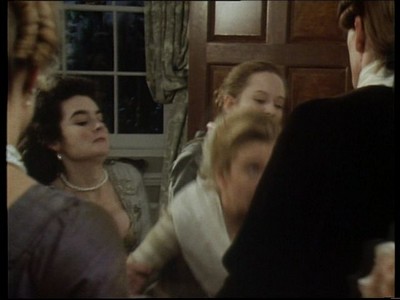
As anyone who knows anything about eighteenth-century novels knows, the villain-protagonist of Samuel Richardson's Clarissa is said to have raped its victim heroine. Robert Lovelace drugs, has his prostitutes hold down and subjects Clarissa Harlowe to hours of harrowing humiliating sex. As he puts it at dawn, “between terror, and the late hour, and what followed, she was diverted from the thoughts of getting out of the house to Mrs Leeson's, or anywhere else.” Her words show she was left with searing memories:
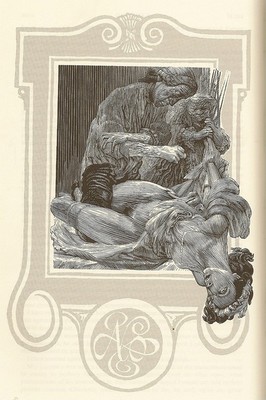
“no mercy found I -- My strength, my intellects failed me! -- and then such scenes followed -- oh my dear, such dreadful scenes! -- fits upon fits (faintly indeed and imperfectly remembered) procuring me no compassion -- but death was withheld from me" (SR, Clarissa, II:883, 1011; Letters 256, 314).1
Except for Richardson's immediacy, there is nothing unusual at this moment when it comes to rape either in life or texts. Since features caught here repeat across centuries and cultures, while what the experience of rape consists of remains contested,2 I must define my terms and suggest something of the variation in depiction to discuss rape in Clarissa.
I divide rape into two main types, and exemplify the first, simple rape, with what happened in Clarissa on the night Lovelace faked a fire in Mrs Sinclair's brothel. Simple rape is an event where someone is compelled to submit to, or participate in, a physical sexual interaction which includes fucking, sodomy, fellatio or cunnilingus. Central is a loss of agency or control which occurs when the first onslaught is an event that goes well beyond the target's expectations. When, with the help of the madam and prostitutes, after Lovelace provokes the (we are told by her family) physically “timid” now isolated already nervous Clarissa into unlocking, opening her door, and going into fits, he forcibly opens her smock
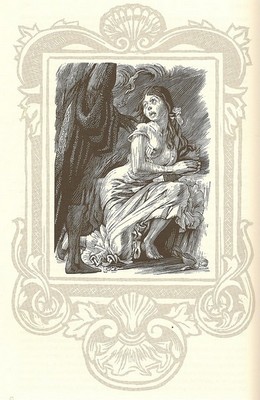
and proceeds to accost her with fierce aggression. She fends him off by seizing a nearby “pair of sharp-pointed scissors” (seen in the 1991 film),3
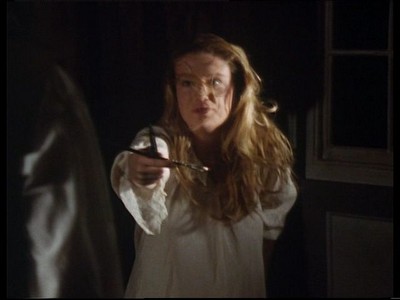
which he wrests back and throws “in the chimney.” Then for a page and one-half he imposes violent foreplay on her, his hands invasive and insistent, “If I am a villain, madam – And then my grasping but trembling hand . . . She tore my ruffle, shrunk from my happy hand, with amazing force and agility . . . (SR, Clarissa, 1, 725-6, Letter 225;). The film visualizes him holding her down on the bed
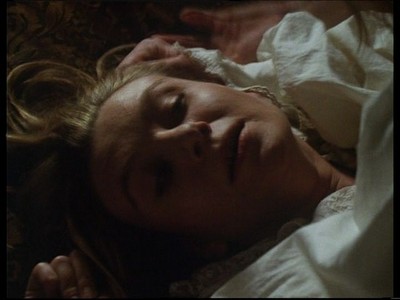
She manages to push him off her, reposition herself and he loses the initiative. As the price of his leaving the room, he extracts a promise she will forgive and see him tomorrow, as if nothing had occurred, and departs. Clarissa keeps no coerced promises.
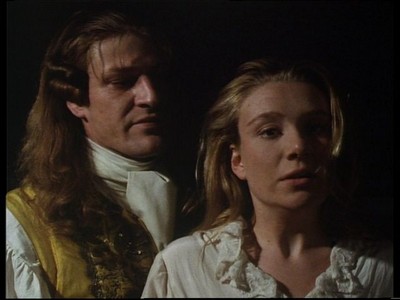
In the eighteenth century novel, such rapes usually feature victims who are unable to consent: she is drugged, handicapped, unconscious, or under age: examples occur in Davy's An Accomplish'd Rake, Riccoboni's Letters of Juliette Catesby and Kleist's Marquise of O. Simple rapes also occur in the form of disguised masquerade surprises (Haywood's The Lucky Rape); in LaClos's Dangerous Liaisons, coercion also includes an accomplice, embarrassing nakedness, threats of exposure (LLD, 87, 203-4, Letters 44, 97). The crucial context is a stressful coercive social situation (fraternity gang-rape is a modern example). Unsuccessful as well as successful simple rapes are actionable.4
I define a second type, aggravated rape, as a situation where the rapist uses extrinsic highly visible violence (weapons), where there are multiple assailants, a high degree of brutality and/or beating, or where there is no prior relationship between victim and rapist. Beyond the June night I described above, Lovelace attempts this kind of assault on Clarissa twice more. He tries during one of the seven (by my count) determined attempts Clarissa makes to flee Mrs Sinclair's. He tries again using as his justification her supposed suborning of Dorcas, the whore who has functioned as her personal maid. But after his successful rape, her knowledge of his full character, her alertness, and (in the second instance) willingness to kill herself first:
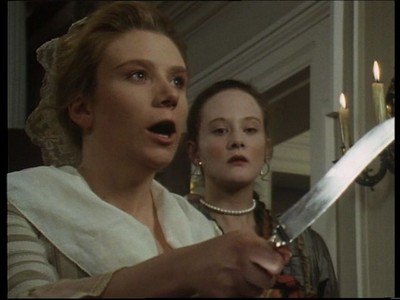
thwarts him (SR, Clarissa, II:898 (June 18), 905 (June 19), 913 (still June 19, only later at night), 917 (June 20), 926 (June 21), 927 (later June 21), 935 (June 22), 961 (June 28), 948-52, Letters 263-64 267, 269, 276, 279).
In eighteenth century middle class and libertine texts outside Clarissa, I have found only one other aggravated rape: of Mary Raymond in Mary Hays's startling The Victim of Prejudice: “Deaf to my remonstrances, my supplications [to] his callous heart, his furious and uncontrollable vehemence [was unstoppable] I suffered a brutal violation” (117).5 Tellingly though, novels or memoirs then and now that circulate among middle class readers commonly center on or include false accusations of rape, and those which include aggravated rape accompany it with murder so the novel becomes a crime mystery and attention is diverted from the rape.6
It has been repeated ad nauseam that Richardson wrote to counter “that dangerous but too commonly received notion that a reformed rake makes the best husband” (Everyman Clarissa I, Preface, xv). What has not been said with clarity is his character conception of Lovelace fits many of the characteristics of recidivist rapists: an absent or distant father, over-present mother, domineering egoism which emerges in his regarding others as objects for him to manipulate; experiences where his violence is rewarded, admired and his stories amuse (SR, Clarissa II:1026-40, Letters 323-26); and his quick impulse to hate as a result of his frequent apprehension he is somehow rejected or insufficiently respected: “oh Jack, the rage of love, the rage of revenge is upon me! (SR, Clarissa II:882, Letter 258). Lovelace's “exercise of viciousness combined with unrestrained privilege” in the post-rape parts of the novel cohere with Jonathan Swift's descriptions of sexual predators in contemporary common life: for example, Lovelace threatens to knock out yet more of his servant Will's teeth and once again stalks Clarissa by ruthlessly bullying and insulting her cowering silent landlords (SR, Clarissa, II, 1209:1209-18, 1219-23, 1295, Letters 416, 418, 445).7
In Lovelace Richardson offers us a composite portrait of a man who is eager to rape women. The first letter of the novel by a character to Lovelace who has experienced the real Lovelace, is by his long-time servant and Harlowe mole, Joseph Leman, and there we see Joseph assumes Lovelace is planning to rape Clarissa. In their interchange a list of the young women Lovelace has raped emerges. With a parodic insinuated glee, Lovelace turns what happened in this or that instance that Joe alludes to as “no rape in the case.”
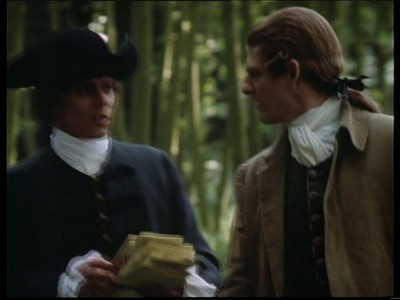
We see how Lovelace set up these earlier situations to make it difficult for the young women to prosecute were they to try (SR, Clarissa, I, 383-6, 494-95, Letters 95-96, 139-140). Upon arriving at Mrs Sinclair's, how Lovelace immediately maneuvers Clarissa into living under the same roof with him and passing as his wife and later how Mrs Moore and her friends believe the same quickly-told stories and ignore Clarissa's statement: “I own no marriage” (SR, Clarissa II:794, Letter 235).
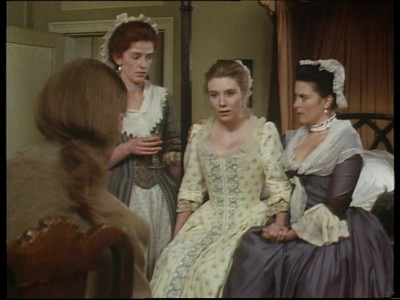
Lovelace's imagining himself with a gang of men abducting and raping Anna Howe, her mother, and whatever woman servant is with them (I:635, 637, Letter 198) ends on (for Lovelace) a triumphant joyful court scene where he imagines, alas rightly, he would not be ostracized nor ultimately punished (Everyman, Clarissa, II:418-25, Letter CIX).9
Lovelace's letters make clear Clarissa is in a dangerous no-win situation: if she yields, he pursues sex without marriage more openly; if she thwarts him, he finds in her behavior further rationale for cruelty. In Lovelace's first letter he tells Belford that he will deprive her of all support, isolate her, and that if Clarissa does not succumb to seduction, she should “take care, fair one; take care” (SR, Clarissa, I:146, Letter 31); this and his third letter (SR, Clarissa, I:164-65, Letter 35) project hatred of women; at their close he becomes intensely exhilarated by imagining himself a violent lion pouncing on someone. Lovelace's fourth and fifth letters to Belford appear after he has abducted Clarissa and in these he displays anger and sexual anxiety at her refusal to acknowledge her dependence, at her continual defiance or unawareness of his power, and at her criticisms of him. He sees his teasing manipulation and seething courtesy as “abjection” and describes himself as having behaved like her “slave” (SR, Clarissa I, 423-26, Letters 108-9). While gripped by half-hysterical emotion, he can propose and seem about to marry Clarissa, but these resolutions never last. He says he prefers rape to consensual sex: “there may be consent in struggle; there may be yielding in resistance” (SR, Clarissa, I:556-67, 589, Letter 170, Letter 184 [Miss Betterton, Miss Lockyer]). When Lovelace contemplates really marrying Clarissa, he ends his letter boasting now he will show he can break her spirit within 24 hours (SR, Clarissa I, 720, Letter 224).
Nevertheless and notoriously, despite all Richardson could do to persuade them otherwise, many readers have persisted in liking Lovelace, some preferring him to Clarissa.10 One obstacle, as modern studies show, is that in life women who openly manifest rage and hysteria about a rape are treated hostilely and/or unsympathetically; they are pressured to subdue anger. They resent characters who have not also yielded. A repressed expression of anger, Clarissa's transparently unreal forgiveness, grates further. Our culture enforces marriage as a goal and socially effective performance, so readers disbelieve Clarissa's assertions she would prefer to remain single, dislike her determination only to love if Lovelace prove himself a congenial companion, and look down on her refusal to play a game of out-manipulation to marry Lovelace early on. She is called a culpable hypocrite or arrogantly proud.11
The problem is the values and behaviors Richardson stigmatizes are found everywhere in a rape-prone society, which studies demonstrate ours still is. Comparative sociology demonstrates that rape is “not the invariable consequence of biologically determined male aggression”, but rather approved complex social processes which prompt individual men to act out their gender, sexuality, desire and bodily impulses in a violent way.12 I read Clarissa as a book intended to make visible our and Richardson's societies' appetite for violence, admiration for competitive aggression, which includes predatory and cruel behavior, especially in males,
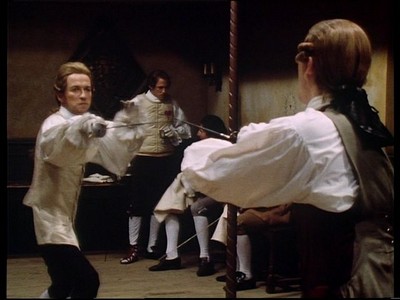
The book also exposes the emotional thinking behind the subjugation of women to family aggrandizement and primogeniture, and the culture of public shaming about sex, which both together prompt honor-killing, of which Morden's murder of Lovelace is a displaced instance.13
In Lovelace Richardson was analyzing a rapist in a fundamental way not seen before.14 His character, Clarissa, participates in the sweeping changes of attitudes in the eighteenth century which we see registered in novels of sensibility.15 In non- or pre-sensibility novels, the nature of characters' sexual experience is a function of their will to dominate or compete. If they do not have a strong will to dominate or impulse to be aggressive and triumph over someone, they are pressured to submit, can be taken advantage of, and, unless they opt out, are often preyed upon as a victim. In novels of sensibility the desire for sex is a desire for sensual experience, physical gratification, for affection, and it includes bonding, tenderness, gratitude, esteem and between the lovers the idea they are equals. So too most film adaptations of eighteenth century texts: In all of these books and films, it is, however, assumed that the sex act is transformative: the woman who has sex with a man with or without her consent, especially if it's the first time, feels she belongs to him, he has rights over her which override her obligations and responsibilities towards others. Not Richardson's Clarissa.18 Unlike most virtuous heroines even to the twenty-first century, once her initial overwhelming distress and terror is over, Clarissa is not subdued and denies she is at all accountable to Lovelace. She seeks Lovelace out and demands to be allowed to choose her fate without reference to him or anyone else. He stunned, refuses. In Diderot's mind, her cry: “What right have you to detain me here?” aligned her with women coerced into nunneries.
The people around her wrench away from the bars, we hear her crying and shouting as they drag her away19
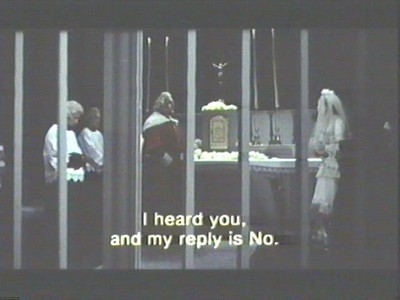
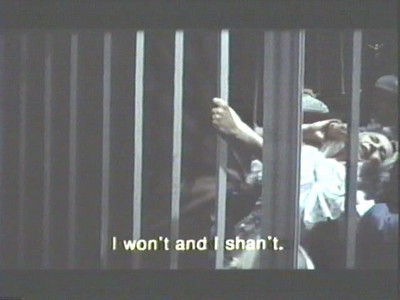
Clarissa too insists she has an inward identity not to be coerced; she is driven to acknowledge she has changed and weakened, but what we see is her trauma, anorexia, physical debilitation and depression which lead to her decision to “want out” develop slowly in response to other people's harsh reactions and their heedless demands made upon her after the rape, and is not a response to the rape itself. She is at her strongest in the novel in the short period after she defies Lovelace and before she is arrested and forced to live in a hideous debtor's prison (SR, Clarissa, II, 1064-66, Letter 334). The only other female character in Richardson's era to defy the virginity taboo (as it's called) is Mary Raymond,20 but Hays's perspective is pragmatic: Hays argues that given what society is, the demand that a woman maintain a reputation for absolute chastity as a condition of respectability to find employment robs them of any opportunity for independence and/or a moral life.21
Freud argues the virginity taboo exists and is enforced so that a man can hope to marry a woman who has never had sex with anyone before; if she now has sex with him, she must stay with him. He is assured his children will be his; his male pride is safe and he's in control of her. If she loses her virginity, no man who knows this will want to marry her. No matter what she does, she's wedded psychologically and socially.22 As if coming out of Freud's script, the women who resemble Clarissa in becoming freed of men they have had sex with, are most often themselves rakes, masculine-like women or in modern novels liberated feminists. Madame de Merteuil, Germaine de Stael's Sophie de Vernon (from Delphine) and Austen's Lady Susan Vernon are Clarissa's peers.23
Richardson makes us see Clarissa is breaking an unjust taboo which imposes a false identity on her: he has Mrs Norton and Mrs Harlowe unable to conceive Clarissa would not marry Lovelace (SR, Clarissa II, 1154-58, Letters 374-75); Mr Wyerly's proposal of marriage refutes the assumption that a raped woman must have a tabooed identity (SR, Clarissa II, 1266-69, Letter 437), and the story of how easily the Rev. Mr Brand finds witnesses and evidence to prove Clarissa is having an affair with next available man, Belford, shows how unexamined attitudes, unthinking lurid gossip, and a desire to curry favor with the hostile members of a raped woman's family are used to bolster a ludicrous presumption that women become promiscuous once exposed to sexual experience (SR Clarissa, II:1296-97, Letter 445). Richardson uses Sally, a prostitute, who nonetheless has taken this taboo seriously, to highlight Clarissa's liberty and dignity. Lovelace was Sally's first lover, and it is Sally who baits Clarissa when Clarissa is imprisoned in the spunging-house. Sally threatens Clarissa with male customers because Clarissa “made those things grievous to her, which would not be made such a rout about by anybody else – “(SR, Clarissa, II:1061-62, Letter 333). We last see Sally amusing Lovelace by “apeing” Clarissa during the rape (“a crying, sobbing, praying, begging, exclaiming, fainting”), and then (in Belford's words) jump at and “cling to [Lovelace] like a cat” (SR, Clarissa, 1217, Letter 416).
Clarissa post-rape, 283 letters out of 537, is still regularly misdescribed, ridiculed and dismissed. Rumor hath it, it is comprised mostly of Clarissa's long-time holy dying. Beyond what I've described above, it also contains her going public, her attempts to gain help from prostitutes, friends, relatives; her three moves; Lovelace's encounter with Anna at an assembly ball; Clarissa's Job-like questioning of God, portraits of Lovelace's relatives, Belford's rejection of his previous existence, and Anna's harrowed reaction to and attempt to interfere with Clarissa's refusal to be coopted, not omit advice about how to treat servants and the limitations of medicine. Richardson's central purpose is to display Clarissa's still remarkable holding out against jeering hostility from her enemies and family, and a lack of insightful empathy from her friends. But he has more in mind than this. In many texts about rape, the rape occurs early; Richardson's novel delays the event, but, like most people concerned with this issue, he explores the consequences of the rape for everyone concerned.25
Thus Richardson also wants us to notice Clarissa's conscious reasons for holding out and how or why she escapes Lovelace. Her refusal to concede any tie to Lovelace is enabled by her tie to God, and by her not conceiving as did Nancy Friendly, Jenny, and the Marquise of O (in Davys's, Riccoboni and Kleist's novels respectively), LaClos's Cecile escapes the coerced marriage her mother had intended for her by miscarrying.26 However, Clarissa's line or argument derives from Richardson's strong Whig and radical Tory politics: Clarissa is a Lockean Enlightenment woman.27 Against Lovelace's assumption that “there is now one man in the world whom she can have – and that is me,” Clarissa counters with clear laws in “a country of liberty such as this” (SR, Clarissa II:901, 915, Letters 263, 268): “No orders of another ought to make [these women] detain a free person.” When Lovelace leaves the house, Clarissa's threat to use the law against the prostitutes prompts them to allow her to escape with ease (SR, Clarissa II:930, 964, Letters 274, 293). Once she is on her own, she makes out a will, appoints an executor so that her property (which she uses to pay her own way when she can) will be inherited in accordance with her judgement (SR, Clarissa II,:1175-77, Letters 389-90; SR, Clarissa II:1055-57, Letter 333; also II:1181, Letter 394). By the end of her experience, she is no longer abject before her relatives (SR, Clarissa, II, 1180, 1260-62, Letter 393, 433). Clarissa grounds herself on her perceived free will, understanding and an entitlement to her soul's and citizen's rights as equal in intellect to all. Her firm and frank pro-active use of law and continued self-esteem, makes her radically unlike any other raped heroine in her century and until today the most useful imagined raped heroine we have.
Richardson's book exposes a rape-prone milieu still with us where women are trained to hide their desires, to repress and to protect themselves.28 Thus Clarissa continues to be a book we need to read, all of it, paying attention to all of its parts. In it we watch Lovelace live and die by a code of male violence which fails to sustain his personal power:
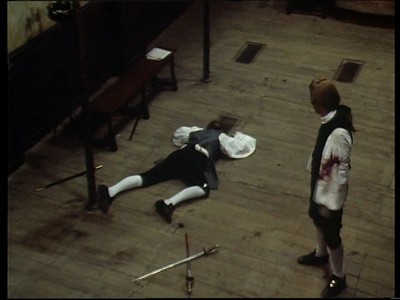
We watch Clarissa given no place where she can exist as herself: on offer are enslavement in the form of marriage to Lovelace, deportation by her family or the existence of a recluse.
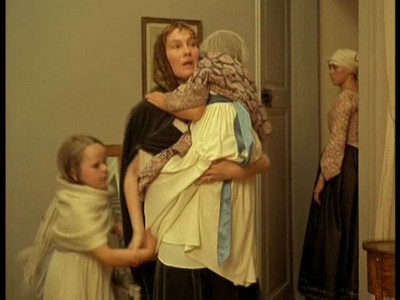
Nearly unique in her era, and still unusual, Clarissa does not let the violations she has endured alter her from within or shatter her identity with others. After the rape, she writes on.
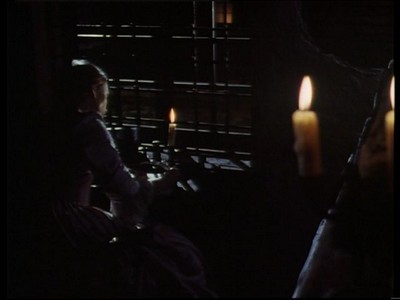
Lovelace will not make her his whore nor will she “grovel” (her word after the rape) like others she's seen (SR, Clarissa, II, 929-30, Letter 274). Like Mary Hay's Mary Raymond, Clarissa refuses to live the inauthentic severely comprised life of a tabooed identity; as a character she can therefore continue to function as a site of resistance for us all.30
Notes
1 My reading text is the Folio Society 1991 reprint of the 1985 Penguin text based on Richardson's first edition edited and introduced by Angus Ross; Samuel Richardson, Clarissa; Or, the History of a Young Lady (Bath: Bath Press, 1991), 2 volumes, with an extra introduction by Angus Wilson, modern illustrations by Simon Brett and a useful table of all the letters in this edition and those in the 1st (C1 produced by Richardson) and 3rd (Shakespeare Head and Everyman editions). I quote Richardson's text in my own and refer to it as SR, Clarissa. Brett's illustration appears facing II:1011. I also used the Everyman text, Samuel Richardson, Clarissa, 4 volumes (1965; rpt. London: Dent, 1932), for those letters in the third edition which either were originally written for and then deleted from the first edition, and placed in the third; or (two other theories) written for the third edition, or represent revisions of letters pulled from the first and re-inserted much changed into a third edition to make Lovelace's character unmistakably frightening and cruel. On the re-insertion and revisions of letters originally intended for the first edition or (possibly) new or wholly rewritten letters, see Mark Kinkead-Weekes, "Clarissa Restored?", Review of English Studies 10 (1959):156-71. In more detail: Van Marter, Shirley. "Richardson's Revisions of Clarissa in the Second Edition," Studies in Bibliography, 26 (1975):107-32; "Richardson's Revisions of Clarissa in the Third and Fourth Editions," Studies in Bibliography, 28 (1975):119-52.
2 I follow Susan Estrich, Real Rape: How the legal system victimizes women who say no (Cambridge, Mass: Harvard University Press, 1987):4-13; see also Malakah T. Notman and Carol C. Nadelson, “The Rape Victim: Psychodynamic Considerations,” American Journal of Psychiatry, 133:4 (1976):408-9. On the continual debates over whether a specific rape was not rape but something else derived from eighteenth century texts, see Frances Fergusson, “Rape and the Rise of the Novel,” Representations, 20 (1987):88-112; derived from a broad range of texts, Catharine MacKinnon's “Feminism, Marxism, Method and the State: Toward Feminist Jurisprudence,” Signs: Journal of Women in Culture and Society, 8:4 (1998), especially 646-55. For what's used to deter women from successful prosecution, see Hubert S. Field, “Rape Trials and Jurors' Decisions: A Psycholegal Analysis of the Effects of Victim, Defendant and Case Characteristics, Law and Human Behavior, 3:4 (1979):261-84. A recent example is the reluctance of the theater and movie community to recognize that Roland Polanski raped Samantha Gailey and should have been held responsible and punished for this, see Jeffrey Toobin, “The Celebrity Defense,” The New Yorker, December 14, 2009, 54-58 particularly.
3 Clarissa 1991 is a commentary type mini-series BBC/WBGH production, screenplay by David Nokes and Janet Barron, directed by Robert Bierman, producer Kevin Loader and executive producer, Michael Wearing. For the cast and company details, costuming, production design, music, which as far as I can check are accurate, go to: http://www.us.imdb.com/title/tt0101066/. For my paper on this film delivered at the 2008 ASECS, see "'How you all must have laughed. Such a witty masquerade:" Clarissa 1991”. I will be showing stills throughout this paper as a visualization of aspects of Richardson's novel.
4 While I have attempted to read widely in fictions where rapes occurred, I have cited only those cases where the rape is made explicit and/or the situation is treated as rape by someone in the novel and/or critics, readers, or scholars. I excluded comic treatment of rape, where rape is attempted and does not occur; for that see Susan Staves's “Fielding and the Comedy of Rape,” History, Gender, and Eighteenth-Century Literature, ed. Beth Fowks Tobin (Athens: University of George Press, 1994):86-112. I also did not attempt to cover rape on the stage. There is still no large general study of rape or its aftermath as depicted across many novels, though Jocelyn Catty shows that women as a group treat rape differently from men in early modern novels in her excellent, Writing Rape, Writing Women in Early Modern England (New York: St Martins, 1999):119-226. Karen Bamford's Sexual Violence on the Jacobean Stage (New York: St Martin's Press, 2000) does not distinguish plays by men from plays by women and has hardly any by women (since these are a minority in the first place).
So just covering prose narratives (fiction and non-fiction), where rape occurs and is treated seriously, when you find rape in nineteenth-century novels, outside commentators tend not to discuss the event as rape. For example, one area where rapes are found, colonial texts: in George Trevelyan's 1868 Cawnpore, a history of the Indian Mutiny or (more accurately) Rising, we read of a woman, Miss Wheeler, giving into her captor sexually to save her life, and then instead of killing herself agreeing to live with him; this is not recognized as rape and the narrator is so uncomfortable he does not give her full name; similarly, Flora Annie Steele in her 1896 Anglo-Indian historical novel, On the Face of the Waters, wants us to see that her heroine, Kate Erlton experiences sex with her husband as rape, but does not make this explicit. While Marguerite de Navarre's 1558 Heptameron includes a number of successful and unsuccessful surprise simple rapes, they have not until recently been treated as such. See Patricia Francis Cholakian, Rape and Writing in the Heptameron of Marguerite de Navarre (Carbondale: So. Illinois University Press, 1991), especially 1-20, 88-105 (the variant where a substituted male is foisted on a woman in the dark). Nancy L. Paxton, Writing Under the Raj: Gender, Race, and Rape in the British Colonial Imagination, 1830-1947 (New Brunswick: Rutgers University Press, 1999):1-20, 269-70; and “Mobilizing Chivalry: Rape in Flora Annie Steel's On the Face of the Waters (1869) and other British Novels about the Indian Uprising,” The New Nineteenth-Century: Feminist Readings of Underread Victorian Novels, edd. Barbara Harman and Susan Meyer (New York: Garland Publishing, 1996):266-71. In her 1832 Valentine, George Sand dramatizes a wedding night where the heroine, Valentine married to man, M. de Lansac, extremely distasteful to her, refuses to be (in effect) raped, but again the word is not used. I am unaware of any essays on Sand that treat this wedding night as an avoidance of rape scene. Published between Indiana and Lelia, Valentine tends to be ignored; but see Kathyrn L. Crecelius, Family Romances: George Sand's Early Novels (Bloomington: Indiana University Press, 1987):81-94.
In the interests of time and coherence, this paper analyzes Clarissa in the direct context of only six other eighteenth-century texts: for those cited in this paragraph see Eliza Haywood, The Lucky Rape, found in Cleomelia; or, The Generous Mistress, Being the Secret History of a Lady Lately arriv'd from Bengal. A Kingdom in the East-Indies. By Mrs Eliza Haywood. To which is added, 1: The Lucky Rape, or, Rate the Best Disposer; II; The Capricious Lover, Or No Trifling with a Woman (London, 1727); Mary Davys's The Accomplish'd Rake, in Mary Davys, The Reform'd Coquet, Familiar Letters Betwixt a Gentleman and a Lady, and The Accomplish'd Rake, ed. Martha F. Bowden (Lexington: The University Press of Kentucky, 1999); Marie-Jeanne Riccoboni, Lettres de Milady Juliette Catesby a Milady Henriette Campley, son amie, preface by Sylvain Menant (Paris: Desjonqueres, 1759), with Frances Brooke's translation, Letters from Juliet, Lady Catesby, to her friend, Lady Henrietta Campley. Trans. From the French (London: R and J. Dodsley, 1760); Choderlos de LaClos's Les Liaisons Dangereuses, ed. Francis Marmande (Paris: Pocket, 1989), with Douglas Parmee's translation, Les Liaisons Dangereuses, introd. David Coward (Oxford: Oxford University Press, 1995); and Henrich von Kliest, The Marquise of O – , trans, ed, introd. David Luke and Nigel Reeves (NY: Penguin, 1978). The marquise's rape occurs in time of war; she is first set upon by a gang of young men. For marital rape one must come forward to the twentieth century, where the often-cited because uncommon instance is Soames Forsyte's rape of his wife Irene, in Galsworthy's 1906 The Man of Property. 5 My text for Mary Hays is The Victim of Prejudice, ed. Eleanor Ty (Ontario, Canada: Broadview Press, 1996). On the boldness of Mary Hays, see Eleanor Ty, Unsex'd Revolutionaries (Toronto: University of Toronto Press, 1993):60-72. I pushed myself to read one eighteenth century pornographic novel, the libertine novel told by a prostitute: the anonymous (sometimes attributed to Diderot) 1748 Therese Philosophe, ed. Florence Lotterie (Paris: Flammarion, 2007) seemed to have no such brutal scene. I admit I have not read John Cleland's Fanny Hill; or The Memoirs of a Woman of Pleasure. I count De Sade's novels as as sheer pornography. Rare recent examples of depictions of aggravated sexual assault without murder include the rape of Daphne Manners in Paul Scott's 1965 The Jewel in the Crown.
It is still true today that it is aggravated assault rape that in western countries gets to court, and even here any circumstance which may be used to arouse the jury or other authority figures' suspicion that the woman in any way consented that may be recognizable by law, can lead to a not-guilty verdict or dismissal of the case. In Alice Sebold's Lucky, when her roommate is raped, the case is not taken to court because the roommate is not beaten up as brutally as Alice was; Alice witnesses a brutal date-rape where the girl does nothing as she feels she will not be listened to because the boy is her boyfriend and she was not a virgin, Lucky (Boston: Little, Brown), 212-29, 240-41. In the eighteenth century the situation was far worse; see Antony E. Simpson, “Popular Perceptions of Rape as a Capital Crime in Eighteenth-Century England: The Press and the Trial of Francis Charteris in the Old Bailey, February 1730,” Law and History Review, 22:1 (2004):27-70.
An exception to all these tendencies are African novels where when rape occurs, it is depicted brutally, e.g.,, two late twentieth century French African novels, La Vie et demie and Le Devoir, see also Alice Sebold's boldly graphic account in 2002 Lucky. For the two French African novels, see Eileen Julien, “Rape, Repression and Narrative Form in Le Devoir de Violence and La Vie et Demie; for the story of how E. M. Forster originally described the attempted rape of Adela Quested in A Passage to India and was pressured to omit it, Brenda R. Silver, “Periphrasis, Power and Rape in A Passage to India; Rape and Representation, edd. Lynn A. Higgins and Brenda R. Silver (New York: Columbia University Press, 1991):115-37, 160-81. The 1995 Rape of Sita (banned in Mauritius) by Lindsey Colleen is about how rapes are erased. The essays suggest that at the same time in Africa it is very difficult under all circumstances for a woman to take a man to court for rape (part of the devaluation of women). Another exception is the rape-revenge horror film; this contemporary genre has been shown to reflect fears, anxieties, and the spread of pornographic images in our era: Jacina Reed, The New Avengers: Feminism, feminity and the rape-revenge cycle (Manchester University Press, 2000); there are persuasive cogent essays which refute the claim that such films are feminist themselves; e.g., Colleen Kennedy, "Simulating Sex and Imagining Mothers," American Literay History, 4 (1992):165-85; Julianne Pidduck, “The 1990s Hollywood Femme Fatale: (Dis)Figuring Feminism, Family, Irony and Violence,” Cineaction, 38 (1995):65-72 and Marita Sturken, Thelma and Louise (London: British Film Institute, 2005):54-72. 6 False accusations of non-rape stories circulate widely, are popular in the eighteenth century and since; see Staves, 90-102; Fielding's 1730 play Rape upon Rape; or, The Justice Caught in his Own Trap and The Coffee-House Politician uses this misogynistic trope. In fact, Charteris, upon whose behavior some of the play is based, was a notorious rapist . A modern popular novel turned into a prize-winning film adaptation, Ian McEwan's Atonement attempts a sort of rewriting of Clarissa where the center of attention is also a false accusation. The wrong man is accused because he is lower class; the effect on a number of my students (with whom I read the book and studied the film) was to create intense dislike of the young woman and her mother who accused the young man, and discuss them as cold vengeful women. The real rapist was hardly discussed, partly because he is a marginalized figure in the book. We also continue to overlook real rape scenes when the targeted victim is a minor character or lower class; in an otherwise exemplary analysis of Les Liaisons Dangereuses, Mary McAlpin does not discuss Valmont and Azalon's treatment of Cecile's maid, an anticipation of and parallel to what they engineer for Cecile, “The Rape of Cecile and the Triumph of Love in Les Liaisons Dangereuses," Eighteenth-Century Studies, 43:1 (2009):1-19.
One typical example from detective mystery fiction must stand for many many: Susan Hill's disquieting The Various Haunts of Men (New York: Vintage, 2005); Muriel Spark's 1970 The Driver's Seat is a realistic novel; at its close the rape is accompanied by heroine's murder.
7 Simpson, “Popular Perceptions of Rape,” shows Lovelace stands for a recognizable type in the era, seen most notoriously in Frances Charteris, whose habits of sexual predation Swift described as commonplace, on pp . 38-39n.39: “here we have … a young wicked Dunces and Atheists,or old Villains and Monsters, whereof four-fifths are more wicked and stupid than Chartres,” seems to suggest that the rapist of the period was not limited to aristocrats.” For a recent study which shows the characteristics found in Richardson's Lovelace, see David Lisak, “Aggression, Masculinity and Fathers,” Signs 16:2 (1991):238-62. I agree with Eaves and Kimbel that in Richardson's letters he often expresses a “personal hatred” for Lovelace, Eaves and Kimbel, 239.
8 Richardson's text (SR, Clarissa, Letters 96, 139-40, I, 385, 494-97) is often read to emphasize Joe's false piety and hypocrisy. On the villain-protagonist rapist of Nabokov's Lolita, who also abducts, isolates and then deprives an adolescent girl of all support, see Azar Nafisi, Reading Lolita in Teheran (New York: Random, 2003):37-60. Humbert Humbert shares a number of characteristics with Lovelace, and he too has his defenders. On the prevalence of rape across many societies, see Shani D'Cruze, “Approaching the History of Rape and Sexual Violence: notes towards research,” Women's History Review, 2:3 (1993):377-96; for a specific instance, Jacques Rossiaud, “Prostitution, jeunesse et societe dans les villes du Sud-Est au XVe siecle, “Annales. Histoire, Sciences Sociales, 31e Annee (1976):289-325. D'Cruze refutes the argument still voiced by Roy Porter (this common male position is not peculiar to him) that rapists are deviant, marginalized men, see Porter's “Rape – Does it have a historical meaning?”, Rape: An Historical and Social Enquiry, edd. Sylvana Tomaselli and Roy Porter (Oxford: Basil Blackwell, 1986):216-37. Porter and Tomaselli include an essay where it is argued that unconsciously women want sexual intercourse even under rape conditions and enjoy violence, even if they do not appear to, John Forrester, “Rape, Seduction, and Psychoanalysis,” 57-83. It is impossible to refute this pernicious notion since the methodology assumes any evidence against it is (in effect) a form of false consciousness; at long last, sociological and studies focused on women's experience of their sexuality and what they really desire are beginning to make this position more and more untenable. See Michelle Fine, “Sexuality, Schooling and Adolescent Females: The Missing Discourse of Desire,” Harvard Educational Review, 58:1 (1988):29-53. But one has to read these studies, and they printed in learned journals and do not circulate widely.
9 According to Antony Simpson, Lovelace's assumption that he will not be punished is probably accurate; he would easily escape punishment because of high rank and his family's patronage powers. See Simpson, “Popular Perceptions of Rape,” 45-57; also his “The 'Blackmail Myth' and the Prosecution of Rape and its Attempt in the Eighteenth Century,” The Journal of Criminal Law and Criminology (1973-), 77:1 (1973):105-50, where Simpson shows that many of the assumptions and customs that shape rape trials today were first codified in the eighteenth century. On the use of epistolary fiction as a way of pushing the tabooed material to the “back” of a story and killing off an inconvenient victim (which we also see in Austen's Sense and Sensibility, which I have argued elsewhere was originally epistolary), see Joan Hinde Stewart, “La Lettre et l”interdit,” Romance Review, 80:4 (1989):521-28. The text analysed is Riccoboni's Juliette Catesby.
10 The most unashamed defender of Lovelace is William Warner who gets a kick out of writing misogyny (he calls Clarissa an “uncommon slut”); see his Reading 'Clarissa': The Struggles of Interpretation. Conn: Yale UP, 1979 and Terry Castle's reply Clarissa's Cyphers: Meaning and Disruption in Richardson's Clarissa. (Ithaca: Cornell UP, 1982):192-96; also Terry Eagleton, The Rape of Clarissa (Minneapolis: University of Minnesota Press, 1982):65-69.
11 For a study of the mechanism and pressure put on women to repress their anger, one of the two central and typical responses to rape (the other is fear), see Susan Roth and Leslie Lebowitz, “The Experience of Sexual Trauma,” Journal of Traumatic Stress, 1:1 (1988):90-92, 101-3. Intense repugnance for the rapist and anger is seen in An Accomplish'd Rake, The Victim of Prejudice, at first and in the end in Les Liaisons Dangereuses (to be fair with respect to Valmont's sexual experiences with Cecile we get only Valmont's account), The Marquise of O (for a full year after he reveals himself by the Marquise when his behavior over the year persuades her he is no libertine but rather a man of sensibility), The Man of Property, Lucky, Shattered, The Rape of Sita. We should not dismiss the studies of Clarissa as a puritan hypocrite or “neurotic prude.” No one has written better about this recently than Eagleton, 68-75. Also, again and again the question is asked why she didn't take one of Anna's options: litigate and thus rejoin her society. Recent readers cannot accept that Clarissa is capable of deciding she will not love Lovelace when she gets to know his character before the rape; nor that after it, she is unambitious for high rank and/or social success because they are. For a cogent reply see T. C. Duncan Eaves and Ben D. Kimbel's argument in Samuel Richardson: A Biography (Clarendon Press, 1971): 271: Clarissa's ““triumph depends on her becoming an outcast.” Clearly, the scarcity of depictions of unquestioned aggravated rape unaccompanied by murder in such texts (see notes 5 and 6 above) and the demand women silence themselves supports male hegemonic societies, the present property system, and ruthless materialism and careerism.
12 Nancy L. Paxton, Writing Under the Raj,15-32. See also Peggy Reeve Sanday, Fraternity Gang Rape, Sex, Brotherhood and Privilege on Campus (NY: New York University, 1990). On how general social environment and stories arising from or controlled by understood norms and justifications encourage or discourage rape between specific classes of individuals, see Larry Baron and Murray A. Strauss, “Four Theories of Rape: A Macrosociologial Analysis,” Social Problems, 34:5 (1987):467-89. For a recent useful and brief exploration of sexual attitudes leading to rape in Clarissa, see Isobel Grundy's “Seduction Pursued by Other Means: The Rape in Clarissa,” Clarissa and her Readers: New Essays for the Clarissa Project, edd. Carol Houlihan Flynn and Edward Copeland (NY: AMS Press, 1999):255-68.
I should say I have been motivated to research and write this paper by my own experience of rape in life, those of people I've talked to and corresponded with; see Diana E. H. Russell and Nancy Howell, “The Prevalence of Rape in the United States Revisited,” Signs, 8:4 (1983):688-95; Peggy Reeves Sanday, “The Socio-Cultural Context of Rape: A Cross-Cultural Study,” Journal of Social Issues, 37:4 (1981):5-27; Mary P. Koss, Christine A. Gidycz, and Nadine Wisniewski, “The Scope of Rape: Incidence and Prevalence of Sexual Aggression and Victimization in a National Sample of Higher Education Students,” Journal of Consulting and Clinical Psychology, 55:2 13 If honor-killing were practiced in this novel, Morden would kill Clarissa, and until she dies some of her family members (e.g., her brother, father and uncles) seem to wish her dead rather than endure an imputed shame. Clarissa, it should be recalled, is a book which begins and ends in a bloody duel; the importance of Clarissa's brother, James, to the plot-design reveals a subjugation of females to the eldest male heir and males of families. For a cogent analysis of honor-killing and its variants in modern cultures, see Jacqueline Rose, “A Piece of White Silk,” London Review of Books, 31:21 (2009):5-8, 48-50. I defended the film replacement of Morden with Belford on the grounds of new characterization in my online conference paper, “"'How you all must have laughed. Such a witty masquerade:" Clarissa 1991” (cited above); I also like this substitute because the depiction of Morden killing Lovelace could be experienced as an endorsement of honor-killing; Belford because an ex-friend and someone who once enacted macho-male ruthless norms is a more effective counter to rakery than Richardson's Hickman. For an attempt to explain Richardson's failure to make Hickman a viable alternative to Lovelace, see Shirley Van Marter, “The Unsolved Problem of Clarissa,” The Yearbook of English Studies, 4 (1974):140-48.
Although not dwelt upon by Richardson so insistently, in the 1991 film we see by the way the actresses are dressed, our insistence on seeing women as sexualized objects men trade in. An 18th century film which includes a story which examines this is the 1991 Aristocrats whose screenplay and source texts are by women.
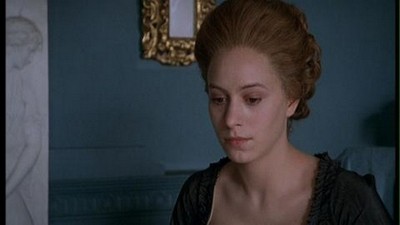
Sarah Lennox is the youngest sister ignored by the parents and in need of more assurance and love than she gets; she succumbs to libertine courtship, which consists of forms of aggressive harassment by males; she endures a coerced marriage to save her from predatory males and is blamed when she still becomes pregnant outside marriage. When she does meet a decent and kind man she is compatible with, the males of her family are against her marrying him because his rank is low and fortune much smaller than theirs; her sisters defend her desire when she agrees to live in retirement with him. See Stella Tillyard, Aristocrats: Caroline, Emily, Louise, and Sarah Lennox, 1740-1832 (New York: Vintage, 1995). Tillyard resorts to describing Clarissa's tragedy to explain some of what happened to Sarah and Caroline (who fled a forced marriage), 241-43. Studied in the context of eighteenth century novels and memoirs, the mini-series itself makes visible how such film function as forms of dialogue with viewers today, see Aristocrats, 1999 BBC mini-series, directed by David Caffrey, screenplay Harriet O'Carroll, produced by David Snodin.
14 Denis Diderot, “Eloge de Richardson,” Oeuvre esthetiques, ed. P. Verniere (Paris: Garner, 1968): 44-46 is not often noted for the stance Diderot takes towards aggressive male sexuality. 15 Studies of the new kinds of feelings and ideas brought forward in the eighteenth century as operative in politics and social life abound. A handy general synopsis is found in Janet Todd's Sensibility: An Introduction (New York: Methuen, 1986); for the novel except for her perspective on Austen, I find myself in accord with Marilyn, Butler, Jane Austen and the War of Ideas (Oxford: Clarendon Press, 1990). French and English novels do not follow the same trajectory; my view is that in the UK sensibility novels begin to predominate in the 1760 s to 70s; in France, the atmosphere and ideas attached to sensibility begin with Prevost, hence the era begins in the 1730s; the existence of libertine novels complicates the matter, but in any case the satiric mind-frame continues in both languages, and first change into Victorianism comes in the 1820s. For women the important studies of French (and English novels by implication) are Margaret Cohen's The Sentimental Education of the Novel (Princeton: Princeton University Press, 1999) and Joan Hinde Stewart's Gynographs (Lincoln: University of Nebraska Press, 1999). The full history is still J. R. Forster, The History of the Pre-Romantic Novel in England (1949; rpt. New York: Klaus, 1966). For a modern study connecting the array of characteristics attached to the ideas about sensibility in the eighteenth century to female psychology and defending it as a superior model to live by is Lyn Mikel Brown with Carol Gilligan, Meeting at the Crossroads: Women's Psychology and Girls' Development (Cambridge: Harvard University Press, 1992) and Carol Gilligan, n a Different Voice: Psychological Theory and Women's Development (Cambridge: Harvard University Press, 1982); they argue this female model should be central to social education. 16 Again examples abound and space does not permit details or analysis. Sensibility novels where sexual experience is expected to be a compound of affection, bonding, equal companionship include (in French) Rousseau's Julie, ou La Nouvelle Heloise , Isabelle de Montolieu's Caroline de Lichtfield, Sophie Cottin's Amelie Mansfield, and (in English), Richardson's Sir Charles Grandison, Mary Hays's Memoirs of Emma Courtney and Amelia Opie's Adeline Mowbray, or, The Mother and Daughter. Pre- or non-sensibility novels where sexual experience is equated with competition, conquest, triumphing, and the experience of pain submitting to a dominating partner inevitably include (the French), Marie-Madeleine de Lafayette's La Princess de Cleves, Marivaux's La Vie de Marianne, Retif de la Bretonne, Ingenue Saxancour, ou La Femme Separe, Stephane-Felicite de Genlis's novels as a group (outlined and exemplified in Adele et Theodore; see also Mademoiselle de Clermont), and (the English), Aphra Behn's Love-Letters between a Nobleman and His Sister, Mary Davys's The Reform'd Coquette, Charlotte Smith's novels as a group (see Desmond, The Young Philosopher). A number of English novelists intermingle sensibility with non-sensibility characters, e.g., Sarah Fielding, Charlotte Lennox, Jane Austen; so do the French, e.g., Germaine de Stael. The 1989 Valmont commentary type adaptation of Les Liaisons Dangereuses turns Valmont into victimized man of sensibility:
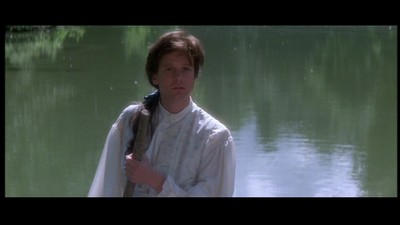
On Valmont as an anti-Thatcherite 1980s era commentary type adaptation, see my blog-essay: Valmont_: an anti-Thatcherite era costume drama.
17 No serious film study has been made of Roger Krumble's 1998 independent film, Cruel Intentions. A good example of give-and-take, with sensuality an important part of the sex act, is Catherine Breillat's 2008 film adaptation of Une veille maitresse; this reflects the year it was made, 2007, not the year of Barbey d'Aurevilly's 1830s novel set in the later eighteenth-century, but is meant in part to be a rewrite of LaClos's Les Liaisons Dangereuses, mentioned by the characters and in the film's intertitles at the opening and close. Veillini is a early nineteenth century version of Madame de Merteuil, deeply subject to erotic enthrallment. A film studies paper at the 2009 Richmond ASECS concurs with the points I make here: from the panel, “Envisioning the Eighteenth-Century through—or against—film, I” (Thurs, 11:30-1:00 pm). Bradley S. Reichek talked about Catherine Breillat’s Une vieille maistresse (2007); see my online summary, The Eighteenth Century On Film. Also “Unbecoming Sexual Desires for Women Becoming Sexual Subjects,” Simon de Beauvoir (1949) and Catherine Breillat (1999), MLN, 119 (2004):673-95. See also Michael Caton-Jones's 1995 film adaptation of Scott's Rob Roy. For an essay which may be read as confirming this “sensibility” approach to sexuality and male and female relationships in recent films, see Catherine N. Parke's “Adaptations of Defoe's Moll Flanders,” Eighteenth-Century Fiction on Screen, ed. Robert Mayer (Cambridge: Cambridge University Press, 2002):52-69.
18 Eaves and Kimpel write that the “distinctive feature of Richardson's conception of Clarissa's tragedy, the reversal in which she rises above her seducer [rapist they should have said] by refusing to marry him … [] is that makes the book “important,” 255.
19 That Diderot saw this parallel is seen in his La Religieuse, not published as a separate book for the public until after the revolution (1796), and until today seen as too subversive; see Richard Frohock "Adaptation and Cultural Criticism: Les Liaisons Dangereuses 1960 and Dangerous Liaisons, Kevin Jackson, "'Carnal to the point of Scandal:' on the affair of La Religieuse," Mayor, 170-71, 153; also Claire Clouzot, "La Religieuse by Jacques Rivette," Film Quarterly, 22:3 (1969):44-47; Tom Milner, "La Religieuse," Film Reviews, 1969, pp. 38-39. A study which illuminates much of the process Clarissa and Suzanne go through is Judith Lewis Herman, Trauma and Recovery: The aftermath of violence – from domestic violence to political terror (New York: Basic Books, 1992), especially 1-96. The stills are from the 1966 La Religieuse directed by Jacques Rivette, screenplay Jean Gruault, produced by George de Beuregard, starring Anna Karina as Suzanne.
20 Outside the novel, Sarah Fielding is a contemporary witness on behalf of Clarissa's original “frankness of heart” (her openness throughout the novel) and defender of Clarissa's behavior after the rape is defended; Fielding delights in Clarissa's independence and scorn for Lovelace, see Sarah Fielding, “Remarks on Clarissa,” introd. Peter Sabor (Los Angeles: Williams Andrews Clark Memorial Library, 1985):29-35, e.g, Clarissa's “Conduct” was meant to be “a direct Opposition to that of all those whining Women, who blubber out an humble Petition to be joined for Life to the Men who have betrayed them.” So too does Barbauld understand the issues at stake and defend Clarissa eloquently and persuasively, see “On the Origin and Progress of Novel Writing,” Anna Letita Barbauld: Selected Poetry and Prose, edd. William McCarthy and Elizabeth Kraft (Ontario: Broadview Press, 2001):364-74.
21 See Mary Hays, The Idea of Being Free: A Mary Hays Reader, ed. Gina Luria Walker (Ontario: Broadview Press, 2002):217-48. She also argues that this faultline supports the private property system which gives all to the eldest male. Thus it was peculiarly dismaying to me to hear a paper read aloud about The Victim of Prejudice in a recent EC/ASECS conference where the speaker argued Mary should have married the farmer her guardian picked out for her, sight unseen, for then she would not have suffered so, remained part of her society and safe. This is to miss the central themes of Hays's book and its importance for us today.
22 Sigmund Freud, “The Most Prevalent Form of Degradation in Erotic Life,” “The Taboo of Virginity” and “Female Sexuality,” translated by Joan Riviere, Sexuality and the Psychology of Love, ed. Philip Rieff (NY: Collier, 1963):58-86, 194-211.
23 Common to discussions of Madame de Merteuil (and found in criticism of Stael's novel too) is the assertion that Merteuil is masculine, a man's idea of a woman. See Antoinette Marie Sol, Textual Promiscuities (Lewisburg: Bucknell University Press, 2002:112-24 (Riccoboni's complaints in her correspondence with LaClos are elucidated). On Delphine, see Germaine de Stael, Delphine, translated by Avriel Goldberberger (Northern Illinois Press, 1995) and Madelyn Gutwirth, Madame de Stael, Novelist: The Emergence of the Artist as a Woman (University of Illinois Press, 1978):102-54.. When James-Edward Austen-Leigh published his aunt's Lady Susan as an appendix to his 1871 second edition of his Memoir, he was courageous; this heroine has rarely been brought properly into public awareness or the Austen canon as an important presence; exceptions include the much misunderstood, Marvin Mudrick, Jane Austen: irony as defense and discovery (Los Angeles: University of California Press, 1952):127-54, and Deborah Kaplan, Jane Austen Among Women (Baltimore: John Hopkins, 1992):159-70. No one has mentioned the connection between Delphine and Lady Susan in the established in print Austen criticism.
24 In an email letter to me, David Nokes, one of the two writers of the screenplay used as the basis of the 1991 BBC film adaptation, Clarissa, lamented that “originally” the film was intended to be one-quarter again as long, but the producer had been afraid that the matter in the “last 500 pages would not be popular.” The executive producer, Michael Wearing, thought the last quarter of the novel was basically comprised of religious preaching and Clarissa's dying. As I argued in my paper referenced above, the central fault of the mini-series is its brevity. The harm done is wider, but the film having left out this “impossible” last quarter reinforced the notion that the novel has only tedious moralizing when its post-rape section is as important the section leading up to and describing the rape. Eaves and Kimpel are again among those who understand the novel when they emphasize how important is the post-rape portion, 269-78.
25 In the books read and studied for this paper, this structure of the rape occurring at the outset is seen in Riccoboni's Juliette Catesby (where the rape occurred in a back story before the novel begins), Kleist's Marquise of O, Scott's The Jewel in the Crown (like Kleist's the rape occurs on the opening page or so), Sebold's Lucky (a graphic harrowing description fills her first chapter) and a best-selling memoir, Debra Puglisi and Marjorie Preston's Shattered (New York: Atria, 2003). Like Scott in his Raj Quartet, Puglisi and Preston keep the rape in front of us throughout the book so as to connect it with other attitudes and events; Shattered is one of those books where the rape is accompanied by a murder (of the woman's husband), so the heroine has less trouble going to trial. But still she has difficulty because in her terror and inability to comprehend what had happened (to the point she loses sense of time), she let her rapist keep her imprisoned in his house for nearly a week.
Going public without litigation as Clarissa does is rare: the opening of The Marquise of O is intended to astonish us: the Marquise advertises that she has found herself pregnant outside marriage and asks that her rapist show up in her house on a certain day at a specific time. In novels and memoirs the decision to litigate is often presented as forced on the victim (in all these cases a woman) by circumstances; here Alice Sebold's Lucky is an exception: when she goes public, determines on and forces the litigation, she finds she is treated as a tabooed person, and has to overcome the way her reports (by male police officers) immediately afterwards were written in such a way as to de-emphasize the brutal violence and humiliations she endured.
26 I note that fictions which make the heroine pregnant upon the first rape are unrealistic since it usually takes time or many experiences of sexual intercourse over a period (three to four months would be a common figure), for a woman to become pregnant. The use of this plot-device (a pregnancy) forces the situation into the public and thus forces the female characters in novels where where social norms will harshly punish an unmarried woman who has a child to marry someone. As so many studies have shown since Susan Brownmiller, most women hide their experience and tell no one, but pregnancy also avoids allowing a heroine not to marry. Davys's text suggests Nancy Friendly dislikes her husband and might even feel like Clarissa (that there is no tie) but she overcomes this for the sake of her born child; it is also suggested he will make a poor husband, for he will probably return to his promiscuity, coldness, and irresponsible behavior in general, see The Accomplish'd Rake, 223-26. For a powerful reading of Juliette Catesby which makes clear the misery Jenny endures a married life to a cold indifferent husband, and lonely death, see Susan S. Lansing, “Plot, Voice and Narrative Oubli: Juliette Catesby's Twice-Told Tale,” Eighteenth-Century Women and the Arts, edd. Frederick M. Keemer and Susan E. Lorsch (New York: Greenwood Press, 1988):129-39.
27 The importance of Clarissa's unassailable Christian faith for all aspects of her personality and story has been treated frequently. One example must suffice: Cynthia Griffin Wolff, Samuel Richardson and the Eighteenth Century Puritan Character (Hamden, Conn: Archon, 1972). By contrast, attention to the significance of Richardson's political background and printing and publishing practices and how how his political ideology shapes his novels has been rare; see the insightful Margaret Anne Doody, “Richardson's Politics: Eighteenth Century Fiction, 2:2 (1990):113-26, especially pp 119, 123.
28 The virginity taboo and the notion a woman belongs to a man who was the first to have sex with her is inculcated in many cultures, including non-religious milieus in the US; see Ann Oakley's still important and relevant Subject Women (London: Fontana, 1982), 113-34, 187-235. Oakley shows that the hostility to abortion rights among women derives from their lack of economic opportunities combined with the still active virginity taboo so an open pregnancy it is still hoped will coerce a man into marrying a woman. For a pungent (if lighter, with less argument and statistics) set of meditations on these and related issues, see Katha Pollitt, Virginity or Death (New York: Random, 2006).
29 On how Rohmer changes the radical parodic meaning of Kleist's text so as to empower the heroine through her motherhood and exonerate the hero through his supposed helpless sexual impulses and abject guilt afterwards, see Mary Rhiel, “The Author-Function as Security Agent in Rohmer's Die Marquise von O …, The German Quarterly 64:1 (1991):10-15 especially.
30 See Richard Handler, “Authenticity,” Anthropology Today, 2:1 (1986):2-4; Charles B. Hersch, “Liberalism, the Novel & the Self: Trilling on the Political Functions of Literature, Polity, 24:1 (1991):91-106; and for one extensive application using the line of argument I would make (had I the time and room), Amanda Anderson, “Trollope's Modernity,” ELH, 7 (2007):509-34.
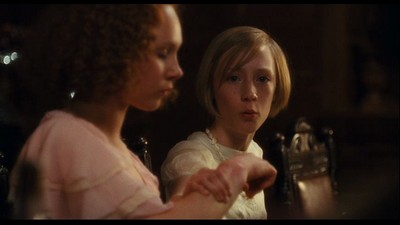
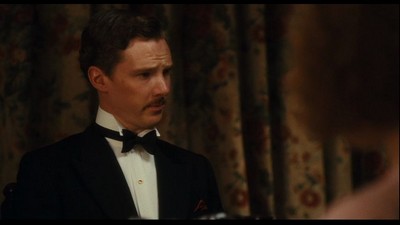
Home
Contact Ellen Moody.
Pagemaster: Jim Moody.
Page Last Updated: 26 March 2010